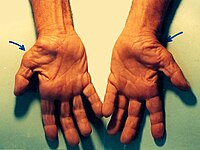
Photo from wikipedia
BACKGROUND Steroid-resistant nephrotic syndrome recurrence post-transplant unresponsive to immunoadsorption is a dilemma, and no reliable treatment strategy has been identified to induce remission so far. CASE PRESENTATION A 2-year-old girl… Click to show full abstract
BACKGROUND Steroid-resistant nephrotic syndrome recurrence post-transplant unresponsive to immunoadsorption is a dilemma, and no reliable treatment strategy has been identified to induce remission so far. CASE PRESENTATION A 2-year-old girl presented first with idiopathic nephrotic syndrome. She did not reach remission after 30 days of oral steroids and remained resistant to steroid pulses, oral tacrolimus, IV cyclosporine, and to 30 sessions of plasma exchange. Bilateral nephrectomy was performed because of extrarenal complications. Two years later, she received an allograft from a deceased donor and idiopathic nephrotic syndrome relapsed immediately post-transplantation. She did not reach remission after immunosuppressive therapy including tacrolimus, mycophenolate mofetil, methylprednisolone pulses, daily immunoadsorption, and B-cell depletion. She received obinutuzumab 1 g/1.73 m2 injections weekly for 3 weeks and then daratumumab 1 g/1.73 m2 weekly for 4 weeks. One week after the last daratumumab infusion, urine protein/creatinine ratio began to decrease. Proteinuria was negative for the first time at Day 99. Immunoadsorption was stopped 147 days after, and she remained relapse-free at last follow-up (18 months post-transplantation). The treatment was complicated by a pneumocystis jirovecii pneumonia with a favorable outcome and persistent hypogammaglobulinemia. CONCLUSION A obinutuzumab and daratumumab combination seems to be a promising strategy in post-transplantation SRNS recurrence without response to standard treatment options.
Journal Title: Pediatric transplantation
Year Published: 2023
Link to full text (if available)
Share on Social Media: Sign Up to like & get
recommendations!